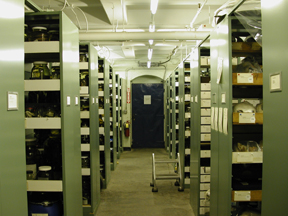|
Home>Harvard>People>Non-Paleo
Ernest Williams, Herpetologist
Ernest became a personal friend and I corresponded with him for another 10 years. Down the hall from Vertebrate Palenotology was Herpetology. This is an image showing a part of the snake collection. Ernest Williams was a faculty member who was chairman at one point. He's the man I corresponded with while I was in Peace Corps Training in Brattleboro, Vermont and later on site in Porangatu, Goias, Brasil.
Salamanders have fascinated me always, especially the mythical story that they can live in fire. While in Vermont, there were many orange newts crawling around the forest floor, composed of wet, decomposing leaves, decaying branches and trunks, mushrooms scattered all over, evergreen needles and tiny pine tree shoots. So it was a natural place to find salamanders.
That led to my first letter to him. The problem was that I wasn't able to find a good book about salamanders in Brattleboro so I figured Ernest would be able to help. He was. He gave me the title of an issue in the 1920's of a journal and the address of the editorial office to write to inquire about obtaining a copy.
I wrote to the office in New York with my request, asking if there were any copies available. They replied promptly and said that, no, there weren't any more copies in the shelves where back stock was kept. But that someone thought there might be a single copy in a back room some where. There was and it was enclosed with a request for $2.50, the original price of the journal decades ago. That inch thick journal is still in my library and was dedicated to the salamanders and newts of New York, just across the river. It holds a couple of pieces of correspondence from Ernest.
I met him in dad's lab not too long after we moved to Boston and he volunteered to show us the herpetology department if we'd like to accompany him. He wore cardigan sweaters and looked like a slightly balding sandy-haired Englishman, affable and pleasant and inoffensive. The visit was worth the effort. The most spectacular specimen to my mind was a rattlesnake. He first showed us old photos of rattlesnake roundups in the southwest when homesteaders got together to clear their territory of these dangerous creatures. They rode horses and killed the fattest snakes Iíve seen in North America, just enormously fat, long specimen bigger than anything Iíd ever seen in any book. These old snakes were so huge that it was actually hard to believe their size except that we were looking at real photos. The specimen he showed us topped anything in the photos. It was just the head. But it filled a glass cylinder that was 8 or 9 inches in diameter and a foot and a half long - those proportions are probably not correct, but they arenít far off. The photos of rattlesnakes taken in Texas in the 1800ís were huge when lying by horses, just enormous, so this head must have been taken from that era..
 
This photo shows what the collection looked like at the time. It was recently remodeled so has modern features. But this was standard, old-style storage. It was set up to securely store specimens for scientific study. There was no provision for the public to enter these spaces, first because of the risk they would post to the collection, and second, because there was basically nothing to see.
Just rows of shelves, filled on both sides with uninteresting jars of various sizes. There were labels on the corridor end of each set of shelves identifying what genera, families or whatever it was, that was found on those shelves. Then when you went to the proper side of the shelves, you could follow the genera down to the species you were interested in.
With the approval of the curator of the section, a person was allowed to take jars down and over to work tables provided for the purpose of study. The specimens could be removed, and examined as necessary, with the obvious caveat that none of them should be harmed, and all should be returned to their places.
I stayed in touch with Ernest for many years. While in Peace Corps I tried to collect specimens for him but had difficulty getting satisfactory embalming solution. All I could really find was their version of rubbing alcohol, an alcohol that is unrefined and smells terrible. Then I had no boxes or jars or anything to handle the specimens. Worse, I didnít trust the local post master. We knew for sure that he opened our mail and I did not trust that he would handle scientific specimens with our interests in mind.
After kids learned I was trying to collect lizards, they would appear with ones they had killed. Their skill was evident in that the injury was minimal. Some of the kids used a small bow, like one used to shoot arrows, but instead of a single string, there were two. In the middle, the strings were separated by two inch long pieces of wood with a fabric strap between to act as a basket. The kids put small rocks into the little basket, pulled the string back, then twisted the basket sideways and let go. The mechanics of the set up were such that the rock would actually bypass the bow and fly straight enough that the kids became proficient enough to hit the lizards on the skull from 6 or so feet. Indians created that design.
|

